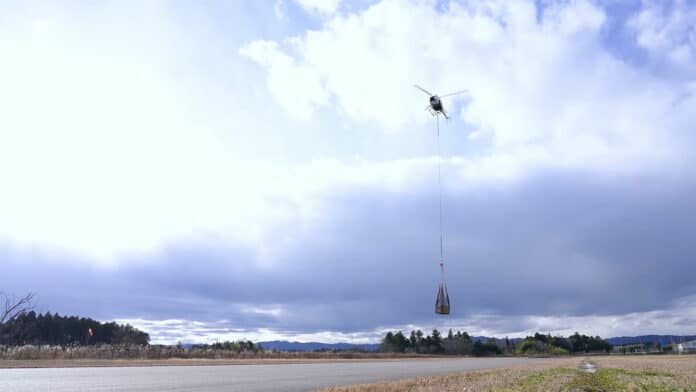Kawasaki Heavy Industries has successfully tested the K-RACER-X2 unmanned demonstration helicopter at the Fukushima Robot Test Field’s Namie Runway. The K-RACER-X2 has a useful load capacity of 200kg, which is the largest ever flown by an unmanned aircraft developed in Japan.
This technology can be used to help solve social issues by hauling heavy cargo loads that cannot be transported with standard drones.
Japan’s mountainous regions are facing the challenge of delivering goods and services to remote areas, where the transport capacity is declining due to a shrinking workforce and other factors. However, there is still a high demand for supplies to mountain huts, as well as for the maintenance and renewal of various public infrastructure in these areas.
This has created a risk of not being able to maintain a balance between supply and demand. To address this issue, there is a need for new distribution services that can meet transport demands, as well as for safe distribution networks that can operate in dangerous and harsh conditions and in case of natural disasters.
Kawasaki has come up with a solution to these issues by utilizing K-RACER to serve unmanned and/or less human cargo transport services. Kawasaki tested The K-RACER concept a few years ago, which showed a lot of promise with its impressive capabilities.
During the initial tests, the focus was on altitude. The prototype, which carried a payload of 220 pounds (100 kg), reached an altitude of up to 2,700 feet (850 meters) above sea level.
The prototype was powered by Kawasaki Ninja H2R motorcycle‘s supercharged engine. The engine was coupled with an innovative chopper configuration that featured propellers on both sides instead of a tail rotor, along with main wings and a main rotor. During flight, the wings helped reduce the load on the main rotor, resulting in better speed compared to conventional helicopters. The propellers on each side also generated thrust for forward movement by countering the main rotor’s torque.
The company has developed an X2 model, which is an upsized version of its original K-RACER concept. The X2 model has a larger main rotor, measuring 7m in diameter, which is an increase from the 5m diameter of the original model. Unlike the previous winged, dual horizontal prop design, it has a traditional helicopter airframe, complete with a conventional tail rotor.
The payload capacity of X2 has been doubled, which means that it can lift up to 200 kg (440 lb) at sea level. Although the top speed has not been specified, the X2 has a range of approximately 100 km (62 miles) and can operate for up to an hour at maximum endurance.
Recently, the K-RACER-X2 became the only unmanned helicopter developed in Japan to demonstrate a 440 lbs payload. The K-RACER is designed to provide an efficient solution for heavy-duty cargo missions that conventional drones can’t support.
Kawasaki is conducting real-world demonstration tests in Ina City, Nagano Prefecture, where it delivers cargo to mountain cabins using K-RACER. Kawasaki is also testing an automated loading and unloading system that requires zero human intervention in order to achieve seamless cargo transport services. Furthermore, Kawasaki is working on the development of a mass-production version of the aircraft.
